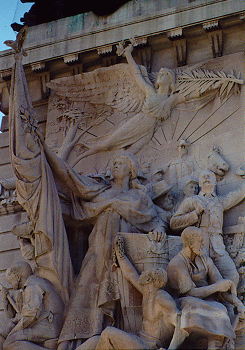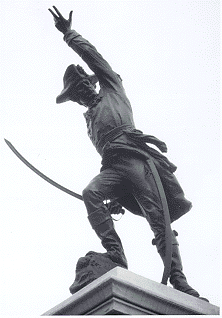 The Four Surrounding Statues
The Four Surrounding Statues
Four bronze statues stand surrounding the monument, one at each of the converging points of the street intersections. William H. English suggested that statues be erected to represent the leading men of noteworthy periods during Indiana's history. George Rogers Clark stands in the northwest quadrant of the circle. He represents the Revolution, and the capture of Vincennes from the British. The statue of Governor Oliver Morton depicts Indiana's Civil War Governor, and a supporter of the construction of Soldiers and Sailors monument. His statue was part of the Circle Park before the Monument was erected. Representing the War with Mexico, stands a statue of James Whitcomb, governor of Indiana during this period. Representing the War of 1812 is William Henry Harrison. John H. Mahoney, of Indianapolis, also the sculptor of the two large figures on the Pilgrims' Monument at Plymouth, Massachusetts, designed three of the statues. The statue of Governor Morton was completed by Franklin Simmons.
Victory
In Victory's right hand is a sword, the top of which rests upon a globe: this symbolizes the army to which victory was due. Her left hand holds a torch, gleaming with gold which represents the light of civilization. The young eagle on her brow is emblematic of freedom. Victory was designed by George W. Brewster. The cost was $13,700.
Army Astragal
The Army astragal represents the carnage of war with cannons, horses, flags and fallen soldiers. Look closely, and you'll see eagles above and bison heads below a crest with the stars and stripes.
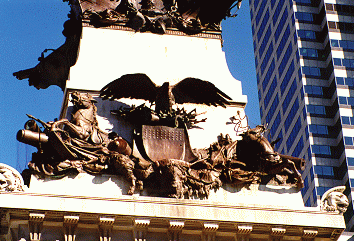
Candelabra
Look closely at the ornate bronze candelabra on stone fountains. You will see that the shaft is fluted to represent stalks of corn. Notice the bison and bear heads and eagles. Near the top is a bronze band with "E Pluribus Unum". A sunburst finial tops the candelabra.
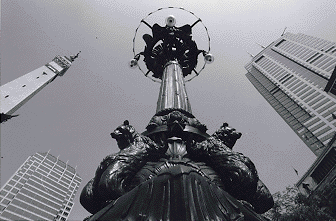
"War"
The "War" sculptural group gives a feeling of aggressive action, as Columbia charges into battle with a torch held high, surrounded by soldiers in the throes of combat. The sculpture includes a cavalry scout, men on horses charging into battle, a drum and a cannon.
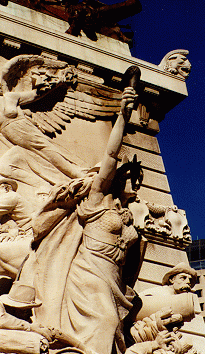
"Peace"
The "Peace" sculptural group represents the homecoming of the victorious troops. In the center, Liberty holds the flag, while at her feet the freed slave lifts his broken chains. A blacksmith, the soldiers marching home, and a husband and wife embracing with a child symbolize the return to families and peaceful pursuits. In the background, Winged Victory bears an olive branch and a laurel wreath.
